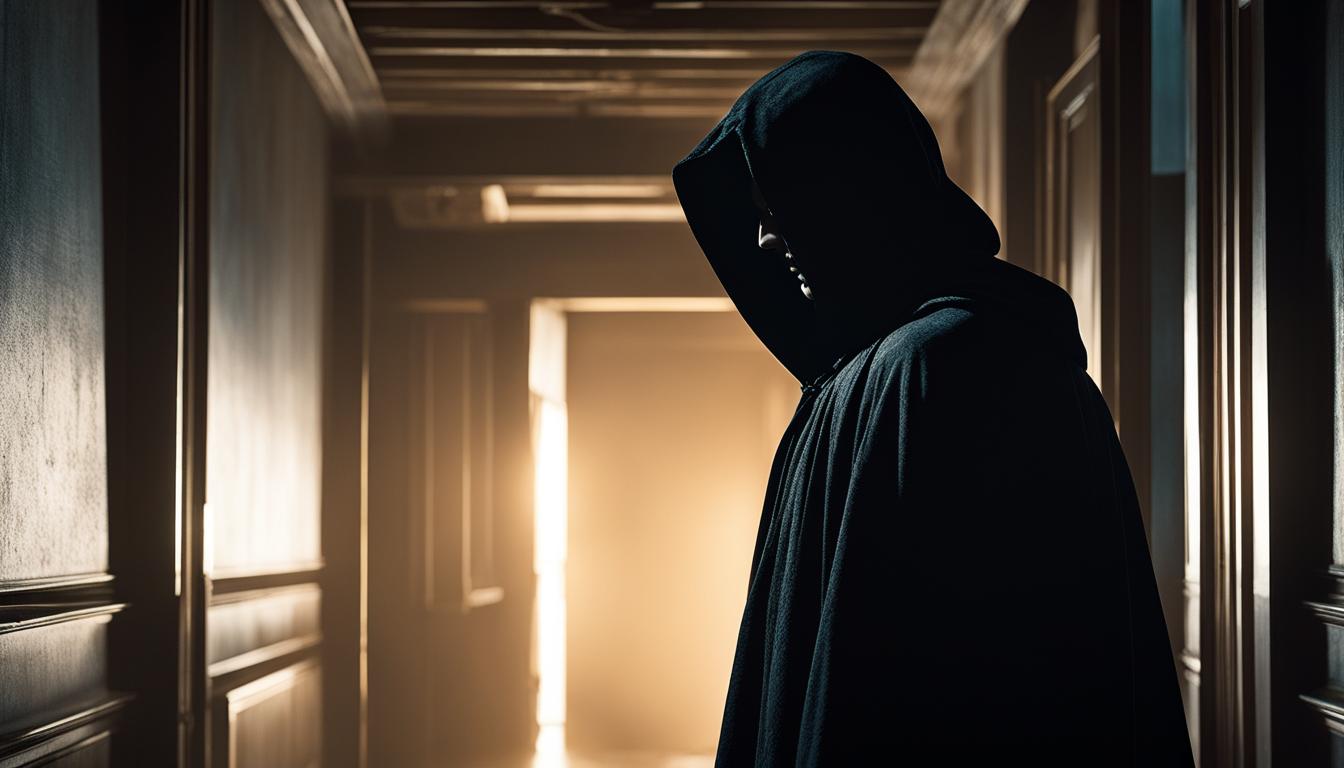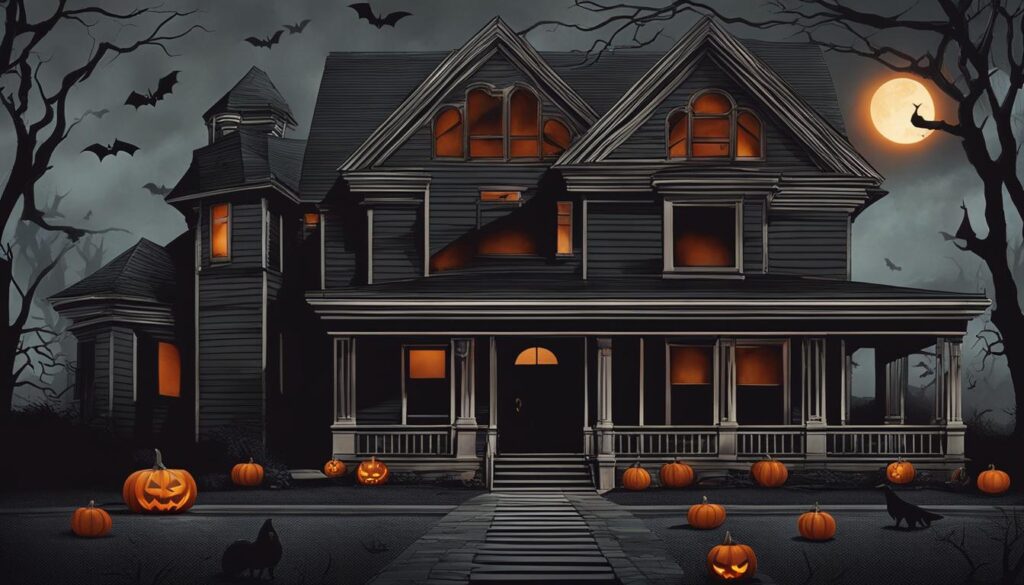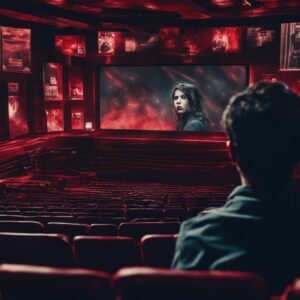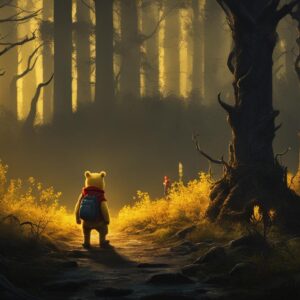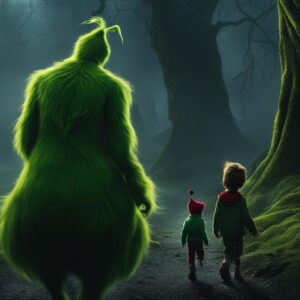Welcome, horror movie enthusiasts! Today, I want to delve into a spine-chilling topic that has captivated audiences for decades – the tiptoe horror movie soundtrack. As a fan of the genre myself, I have always been fascinated by the power of music to enhance the terrifying experience on the silver screen. Join me as we explore the haunting melodies, bone-chilling chords, and unsettling sounds that make up the fabric of horror movie soundtracks.
Key Takeaways:
- The tiptoe horror movie soundtrack plays a crucial role in creating suspense and terror in films.
- Well-timed shrill strings, shrieking synths, and creepy melodies add an eerie layer to the viewing experience.
- Classics like Psycho and Jaws, as well as modern favorites like Insidious and It Follows, showcase the power of the soundtrack in setting the tone.
- Composers like Bernard Herrmann, John Williams, and Danny Elfman have left an indelible mark on the genre with their memorable scores.
- The impact of the tiptoe soundtrack cannot be overstated, as it continues to inspire future generations of horror composers.
The Impact of Psycho’s Score by Bernard Herrmann
Bernard Herrmann’s score for Psycho is a sonic masterpiece that forever evokes a stabbing motion in listeners’ minds. The moody and dynamic music showcases the power of dynamics to evoke distress. The iconic shower scene, accompanied by the piercing staccato strings, remains etched in our memories and is a testament to the influence of Herrmann’s score on horror movie soundtracks.
The score for Psycho is renowned for its ability to create a sense of imminent danger and suspense. Through the clever use of dissonance, Herrmann captures the psychological turmoil of the film’s central character, Norman Bates. The screeching violins and frenetic strings mirror the unraveling of Bates’ mind, sending chills down the audience’s spines.
In addition to the intense orchestration, Herrmann’s score also incorporates innovative techniques such as manipulating the pitch of the strings to create an otherworldly and haunting effect. This manipulation of sound adds an extra layer of terror to the film, heightening the overall sense of unease and fear that Psycho is renowned for.
“The screeching violins and frenetic strings mirror the unraveling of Bates’ mind, sending chills down the audience’s spines.”
The Impact of Psycho’s Score
| Aspect | Impact |
|---|---|
| Suspense | Herrmann’s score creates an atmosphere of suspense that keeps viewers on the edge of their seats throughout the film. |
| Tension | The use of dissonant strings and manipulation of sound enhances the tension and unease felt by the audience. |
| Memorability | The iconic nature of the shower scene and its accompanying score speaks to the lasting impact Herrmann’s music has had on audiences. |
| Influence | The score for Psycho has influenced countless horror movie soundtracks, setting a benchmark for composers in the genre. |
Bernard Herrmann’s score for Psycho remains a defining moment in the history of horror movie soundtracks. Its ability to evoke fear, tension, and suspense is a testament to Herrmann’s mastery of his craft. Through innovative techniques, memorable melodies, and a deep understanding of the power of music, he created a score that continues to terrify audiences to this day.
The Dreadful Tunes of Jaws by John Williams
When it comes to shark movie soundtracks, one name stands out: John Williams. His score for Jaws has become iconic, forever etching itself into the collective memory of moviegoers. The haunting theme, composed of just two ominous notes played on a tuba, immediately conjures images of a lurking predator beneath the water’s surface.
“Duunnn…duunnn…duunnn…”
This simple yet effective melody is a masterclass in creating suspense. As the tempo quickens, mirroring the approaching danger, the tension intensifies. It is no wonder that Williams’ composition won an Academy Award and became one of the most recognizable and fear-inducing pieces of music in cinema history.
Williams’ score for Jaws perfectly captures the dread and imminent threat that the film portrays. Each note, each swell of the orchestra, heightens the sense of unease and keeps audiences on the edge of their seats. It is a testament to the power of music to evoke fear and enhance the viewing experience in ways that visuals alone cannot.
Impact on the Genre
John Williams’ contribution to the horror movie genre cannot be overstated. His ability to craft melodies that tap into our primal fears and create tension has influenced countless composers and filmmakers. The Jaws soundtrack set a new standard for shark movies and horror soundtracks as a whole, demonstrating the impact that a well-crafted score can have on audience engagement and immersion.
| Movie | Composer | Key Element |
|---|---|---|
| Jaws | John Williams | Two-note theme |
| Psycho | Bernard Herrmann | Shrill strings |
| The Shining | Wendy Carlos, Rachel Elkind, Krzysztof Penderecki | Synthesizer-driven music |
In conclusion, John Williams’ creation of the Jaws score stands as a testament to his brilliance as a composer. It remains a prime example of how music can elevate the horror movie genre, instilling fear and unease in the hearts of viewers. The influence of the Jaws soundtrack can still be felt in contemporary shark movies and serves as a reminder of the power that a well-crafted score can have on the overall cinematic experience.
Goblin’s Synth Experimentation in Suspiria
Dario Argento’s Suspiria is a cult classic in the realm of Italian horror movies. Released in 1977, this visually stunning film is known not only for its vivid colors and atmospheric cinematography but also for its chilling soundtrack. The music, composed by the Italian prog-rock band Goblin, pushed the boundaries of traditional horror movie soundtracks with its unconventional approach.
Goblin incorporated a range of innovative techniques and instruments to create a truly unique and eerie auditory experience. One standout feature of their work on Suspiria was their use of the Moog Modular System 55, a complex and powerful synthesizer. This instrument allowed them to explore dark and haunting sounds that added to the tension and suspense of the film.
In addition to the Moog, Goblin also incorporated recordings of their own voices into the soundtrack. These recordings, mixed with cool jazzy twists, unintelligible whispers, screams, and chants, created an unsettling ambiance that perfectly complemented the neon-lit horror on the screen. The result was a mesmerizing and foreboding soundtrack that has become synonymous with the film.
Goblin’s experimentation with synthesizers and their willingness to break new ground in the realm of horror movie music left a lasting impact. Their work on Suspiria set a precedent for future composers and helped cement the film’s status as a genre-defining masterpiece. To this day, the soundtrack continues to captivate audiences and remains an integral part of Suspiria’s enduring legacy.
Influence of Goblin’s Sound on the Horror Genre
“Goblin’s innovative sound in Suspiria revolutionized the use of synthesizers and experimental techniques in horror movie soundtracks. Their ability to create an unsettling atmosphere and heighten the suspense through music paved the way for future composers in the genre.” – Horror Movie Review
Suspiria: A Sonic Journey into Darkness
The combination of Goblin’s synth experimentation and Dario Argento’s haunting visuals in Suspiria created a truly immersive experience for viewers. The music became an integral part of the overall narrative, enhancing the sense of unease and fear. From the opening notes to the chilling climax, the soundtrack guided audiences through a sonic journey into darkness, leaving a lasting impression that transcends the boundaries of traditional horror movie music.
John Carpenter’s Haunting Halloween Theme
When it comes to iconic horror movie scores, one name that cannot be overlooked is John Carpenter. Not only did he direct the legendary Halloween, but he also composed its haunting and instantly recognizable theme. The simple yet chilling melody, played on a Moog III modular System, instantly sends shivers down the spine and sets the tone for the terror to come. The pulsing beat drives the action forward, creating a sense of urgency that keeps viewers on the edge of their seats.
Carpenter’s influence on the horror genre extends beyond Halloween. In the 1980s, his synthesizer-based scores became a hallmark of the era’s horror films. His work on movies like The Fog, Christine, and Prince of Darkness showcased his mastery of creating eerie, atmospheric soundscapes that perfectly complemented the on-screen horrors. Carpenter’s innovative use of electronic music in the genre inspired future composers to explore the dark possibilities of the synthesizer.
The Halloween theme, in particular, has transcended the boundaries of the horror genre and become a cultural phenomenon. Its catchy, unforgettable melody has been covered, sampled, and referenced in countless other works of art. It remains a testament to Carpenter’s ability to create an instantly recognizable and enduring musical motif that continues to send chills down our spines to this day.
The Legacy of John Carpenter
John Carpenter’s contributions to the world of horror movie soundtracks cannot be overstated. His haunting themes and pulsing synth scores have become synonymous with the genre itself. Carpenter’s masterful use of electronic music in films like Halloween and his overall influence on synth horror scores in the 1980s have left a lasting impact on both filmmakers and composers alike.
| Movie | Year |
|---|---|
| Halloween | 1978 |
| The Fog | 1980 |
| Escape from New York | 1981 |
| Christine | 1983 |
The Terrifying Soundtrack of The Shining
When it comes to horror movie soundtracks, few are as haunting and effective as the music in Stanley Kubrick’s The Shining. The combination of composers Wendy Carlos, Rachel Elkind, and Krzysztof Penderecki created a sonic landscape that perfectly complements the unsettling visuals and psychological unease of the film.
The soundtrack of The Shining is a blend of existing concert pieces and synthesizer-driven music, creating a unique and disturbing auditory experience for the viewer. Animalistic squeals and human screams are woven into the composition, intensifying the sense of psychological unraveling portrayed on screen. The music leaves a lasting impact, lingering in the mind long after the movie ends.
Wendy Carlos, known for her pioneering work in electronic music, brings an otherworldly quality to the soundtrack. Her use of synthesizers creates eerie and atmospheric textures, adding to the overall sense of dread. Rachel Elkind’s collaboration with Carlos brings a depth and complexity to the music, blending classical elements with electronic experimentation.
“The soundtrack of The Shining is a masterpiece of sonic terror. The combination of Wendy Carlos’ and Rachel Elkind’s electronic wizardry with the chilling compositions of Krzysztof Penderecki is truly a nightmare-inducing experience.” – Horror Movie Monthly
Krzysztof Penderecki’s inclusion in the soundtrack further amplifies the horror. Penderecki is known for his avant-garde compositions and his ability to create dissonant and unsettling music. His pieces, such as “Utrenja: The Entombment of Christ”, perfectly capture the atmosphere of The Shining, adding a layer of unease that permeates every scene.
The soundtrack of The Shining is a testament to the power of music to enhance the overall viewing experience in horror films. The collaboration between Wendy Carlos, Rachel Elkind, and Krzysztof Penderecki creates a sonic tapestry of terror that perfectly complements the unsettling visuals and psychological horror of the film.
Table: Comparison of The Shining’s Soundtrack Composers
| Composers | Style | Contribution |
|---|---|---|
| Wendy Carlos | Electronic, Experimental | Created eerie and atmospheric textures with the use of synthesizers |
| Rachel Elkind | Classical, Electronic | Brought depth and complexity to the soundtrack through collaboration with Wendy Carlos |
| Krzysztof Penderecki | Avant-Garde, Dissonant | Added dissonance and unease with his avant-garde compositions |
Charles Bernstein’s Nightmarish Nightmare on Elm Street Score
When it comes to iconic horror movie soundtracks, Charles Bernstein’s score for Nightmare on Elm Street is not to be overlooked. Released in 1984, this synth-driven soundtrack perfectly captures the nightmarish essence of Wes Craven’s classic slasher film.
Bernstein’s use of synthesizers, such as the Oberheim OB-SX, Roland drum machine, and Juno-106, creates an eerie atmosphere that intensifies the sense of dread and terror. The reverb-heavy percussion and unnerving strings heighten the suspense, keeping viewers on the edge of their seats throughout the film.
“One, two, Freddy’s coming for you…”
This famous line, accompanied by Bernstein’s chilling melody, has become synonymous with the Nightmare on Elm Street franchise. The repetitive nursery rhyme-like tune blurs the lines between reality and dreams, adding an unsettling layer to the film’s narrative.
The Influence of Synth Horror Scores
Nightmare on Elm Street marked a turning point in horror movie soundtracks, ushering in a new era of synth-driven scores. Bernstein’s innovative use of electronic instruments and his ability to create haunting melodies paved the way for other composers in the genre.
As the ’80s progressed, synth horror scores became increasingly popular. Films like Halloween, The Fog, and Friday the 13th all utilized electronic music to heighten the tension and provide a unique auditory experience for audiences.
The impact of Charles Bernstein’s Nightmare on Elm Street score can still be felt today, as modern horror films continue to draw inspiration from the synth-driven soundtracks of the past. It remains a testament to the enduring power of music to enhance the fear and unease that horror movies strive to create.
| Horror Movie Soundtrack | Composer | Year |
|---|---|---|
| Psycho | Bernard Herrmann | 1960 |
| Jaws | John Williams | 1975 |
| Suspiria | Goblin | 1977 |
| Halloween | John Carpenter | 1978 |
| The Shining | Wendy Carlos, Rachel Elkind, Krzysztof Penderecki | 1980 |
| Nightmare on Elm Street | Charles Bernstein | 1984 |
Danny Elfman’s Spooky Fun in The Nightmare Before Christmas
The Nightmare Before Christmas is a dark fantasy film that has captivated audiences of all ages with its unique blend of whimsy and darkness. At the heart of this captivating film is the enchanting and haunting score composed by Danny Elfman. Elfman’s music brings to life the magical world of Halloween Town and the plight of Jack Skellington, the Pumpkin King, as he discovers Christmas.
From the iconic Halloween anthem “This is Halloween” to the whimsical yet introspective track “What’s This?”, Elfman’s music perfectly captures the spirit of Tim Burton’s visionary film. The score seamlessly transitions between moments of spooky fun and heartfelt emotion, creating an immersive experience for viewers. Every melody, every note adds depth and richness to the world of The Nightmare Before Christmas, making it a beloved film for generations to come.
Elfman’s collaboration with Tim Burton extends beyond The Nightmare Before Christmas. Their partnership has resulted in memorable scores for films like Edward Scissorhands and Beetlejuice, where Elfman’s music enhances the hilariously dark and fantastical elements of Burton’s storytelling. Together, Elfman and Burton have crafted a unique cinematic style that continues to captivate audiences and leave a lasting impact on the world of dark fantasy.
The Nightmare Before Christmas and its enchanting soundtrack are a testament to Danny Elfman’s talent as a composer. His ability to weave together haunting melodies, catchy rhythms, and an otherworldly atmosphere adds a layer of depth and magic to the film. The music of The Nightmare Before Christmas transports viewers to a world where Halloween and Christmas collide, where darkness and whimsy intertwine, and where the power of music brings it all to life.
Conclusion
Horror movie soundtracks have forever changed the way we experience fear on the big screen. From the iconic scores of classics like Psycho and Jaws to the eclectic experimentation of films like Suspiria and The Shining, music has the power to create suspense, terror, and unforgettable moments.
Composers like Bernard Herrmann, John Williams, and Danny Elfman have left an indelible mark on the genre, crafting memorable scores that continue to resonate with audiences. Their innovative use of instruments, haunting melodies, and manipulation of dynamics have become the blueprint for future horror composers.
Whether it’s the shrill strings of a shower scene, the ominous pulse of an approaching predator, or the eerie whispers and chants of an Italian giallo, horror movie soundtracks heighten our senses and immerse us in a world of terror. These memorable scores not only provide a backdrop to the horror unfolding on screen but also play a crucial role in building tension, creating jump scares, and enhancing the overall atmosphere of the film.
As we continue to explore the depths of fear in cinema, the impact of music in horror films remains undeniable. As a viewer, I am grateful for the talented composers who have enriched the genre with their haunting compositions. Their ability to tap into our deepest fears through sound is a testament to the enduring power of horror movie soundtracks.
FAQ
How does the tiptoe horror movie soundtrack contribute to the viewing experience?
The tiptoe horror movie soundtrack plays a crucial role in creating suspense, terror, and an immersive experience for viewers. It sets the tone, adds a layer of unease, and enhances the overall viewing experience in horror films.
What are some iconic horror movie soundtracks?
Some iconic horror movie soundtracks include Psycho, Jaws, Suspiria, Halloween, The Shining, Nightmare on Elm Street, and The Nightmare Before Christmas.
Who composed the score for Psycho?
The score for Psycho was composed by Bernard Herrmann.
How did John Williams create suspense in Jaws?
John Williams created suspense in Jaws by using two notes played a semitone apart on the tuba, gradually increasing the tempo as the shark draws closer, which heightened the tension for viewers.
What unconventional instruments were used in Goblin’s Suspiria soundtrack?
Goblin incorporated unconventional instruments like the Moog Modular System 55 and recordings of their own voices in the Suspiria soundtrack.
Who composed the haunting Halloween theme?
The haunting Halloween theme was composed by John Carpenter.
What is notable about the soundtrack of The Shining?
The soundtrack of The Shining seamlessly blends existing concert pieces with synthesizer-driven music, featuring animalistic squeals and human screaming to intensify the psychological unease portrayed on screen.
Who composed the score for Nightmare on Elm Street?
The score for Nightmare on Elm Street was composed by Charles Bernstein.
Who composed the spooky fun score for The Nightmare Before Christmas?
The score for The Nightmare Before Christmas was composed by Danny Elfman.
What impact do horror movie soundtracks have?
Horror movie soundtracks have a lasting impact on viewers, enhancing the suspense, terror, and creating unforgettable moments in the films. They set the tone and add an extra layer of unease to the overall viewing experience.

